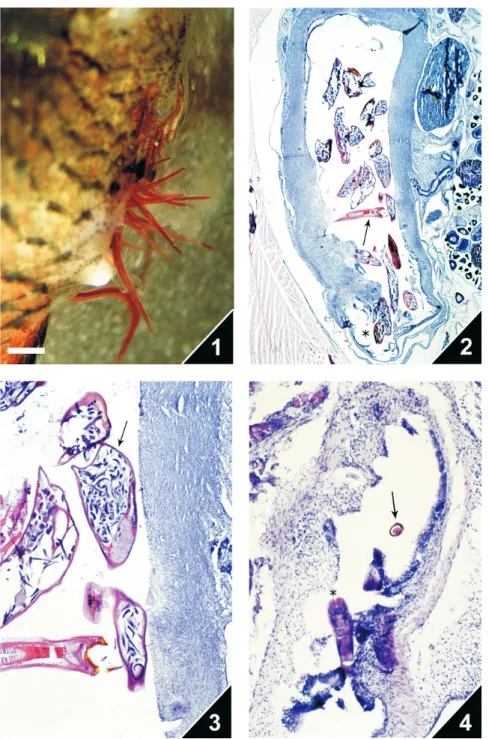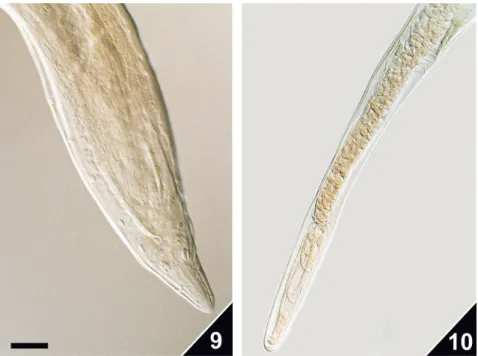683 683 683 683 683 Mem Inst Oswaldo Cruz, Rio de Janeiro, Vol. 101(6): 683-687, September 2006
Camallanus cotti
Fujita, 1927 (Nematoda, Camallanoidea) in
ornamental aquarium fishes: pathology and morphology
Rodrigo Caldas Menezes*, Rogério Tortelly**, Roberto Tortelly-Neto***, Dely Noronha,
Roberto Magalhães Pinto/
+/
++Laboratório de Helmintos Parasitos de Vertebrados, Departamento de Helmintologia, Instituto Oswaldo Cruz-Fiocruz, Av. Brasil 4365, 21040-900 Rio de Janeiro, RJ, Brasil *Centro de Criação de Animais de Laboratório-Fiocruz, Rio de Janeiro, RJ, Brasil **Departamento de Patologia, Faculdade de Veterinária, Universidade Federal Fluminense, Niterói, RJ, Brasil ***Mestrado em
CiênciasVeterinárias, Faculdade de Veterinária, Universidade Federal Fluminense, Niterói, RJ, Brasil
The pathology induced by the nematode Camallanus cotti in the aquarium fishes Beta splendens (beta fish) and Poecilia reticulata (guppy) consisted of gross and microscopic lesions, the former characterized by abdominal swell-ing with reddish parasites protrudswell-ing from the anus in both fish hosts and the latter, similar in the beta fishes and guppies, by hemorrhage, congestion, edema, a few glandular elements, and extensive erosion areas in the rectum mucosa, with a marked thickening of the wall and absence of inflammatory infiltrate. Lesions were associated with the presence of several worms attached to the wall or free in the rectal lumen. This is the second reference of the parasite in Brazil and the first report of pathological findings related to this nematode species that is also briefly redescribed and illustrated for the first time on the basis of Brazilian samples.
Key words: nematodes - freshwater fishes - Camallanus cotti - pathology - Brazil
Ornamental fishes are of increasing economic impor-tance worldwide taking into account the continuous trade involving several species that are either exported or im-ported from a couple of countries, mostly from Asia (Evans & Lester 2001, Kim et al. 2005). The importation generally involves the introduction of exotic parasites that can af-fect a large number of hosts and the detection of parasit-ism is an important step to avoid the spreading of fish diseases among the native fauna.
This paper deals with the first data on the pathology induced by the exotic nematode Camallanus cotti Fujita, 1927 in two species of ornamental fishes kept in an aqua-rium in Niterói, state of Rio de Janeiro, Brazil; C. cotti is briefly redescribed and figured.
MATERIALS AND METHODS
Five adult guppies [Poecilia reticulata (Peters, 1859)] three males and two females and two adult females of the beta fish [Betta splendens (Regan, 1910)] were investi-gated for helminths. The fishes were kept in a home aquarium, for two months and had been purchased in a pet shop located in Niterói, state of Rio de Janeiro, Brazil. The guppies formerly derived from a fish farmer main-tained in the state of São Paulo, Brazil. Fishes were necrop-sied in accordance with ethical procedures and dissected organs kept in Petri dishes with a 0.85% NaCl solution for the recovery of worms under a stereoscope microscope.
+Corresponding author: rmpinto@ioc.fiocruz.br ++CNPq fellowship
Received 11 May 2006 Accepted 5 July 2006
Nematodes were fixed with steaming AFA (70º GL etha-nol, 93%; formaldehyde, 5%; glacial acetic acid, 2%) and stored as wet material in the same solution; some were further dehydrated in an ethanol series, clarified in glacial acetic acid, phenol and preserved as whole mounts in beechwood creosote and Canada balsam. A couple of parasites were stained with alcoholic chloride Langeron’s carmine. Samples are deposited in the Helminthological Collection of the Oswaldo Cruz Institute (CHIOC). Por-tions of the parasitized intestines were removed and im-mediately fixed in 10% formalin, to be further routinely processed for paraffin embedding. Five micrometers thick sections were stained with hematoxylin and eosin (HE).
“En face” jelly mounts of the nematodes were ob-tained in accordance with the method of Anderson (1958) and photomicrographs in a Zeiss Axiophot bright-field microscope with a Differential Interference Contrast (DIC) apparatus and in a Leica stereomicroscope (live parasites). Identification of the nematodes was based on data after Moravec and Nagasawa (1989). Measurements are in mil-limeters (mm) and means in parentheses.
RESULTS
Three of the five guppies and the two beta fishes ex-amined were positive for nematodes.
684 684 684 684
684 C. cotti in ornamental aquarium • Rodrigo C Menezes et al.
Fig. 1: live Camallanuscotti adult worms protruding from the anus of a beta fish. Bar = 0.6 mm. Bar of Fig. 1 is common to Figs 2- 4. Fig. 2: cross-section of the rectum of a specimen of beta fish, showing adult specimens of C.cotti free in the intestinal lumen (arrow) or attached to the remarkably thickened wall associated to extensive areas of erosion of the mucosa (asterisk) and absence of inflammatory infiltrate. HE. Bar = 0.5 mm. Fig. 3: cross-section (detail of Fig. 2) showing adult mature females of C.cotti free in the intestinal lumen, with several larvae in utero (arrow). HE. Bar = 0.3 mm. Fig. 4: cross-section of the rectum of a guppy infected with C.cotti worms, showing a portion of the nematode free in the lumen (asterisk) and the buccal capsule (arrow) inserted in the intestinal mucosa. Bar = 0.7 mm.
Camallanus cotti Fujita, 1927 (Figs 6-10)
Redescription based on five adult males and five adult females.
Males - Total length 3,440-4,240 (3,901), maximum width 0.171-0.220 (0.195). Buccal capsule 0.083-0.100 (0.093) long, 0.076-0.102 (0.091) wide, including ring at base 0.005-0.009 (0.009) long, 0.058-0.069 (0.063) wide. Buccal capsule with
685 685 685 685 685 Mem Inst Oswaldo Cruz, Rio de Janeiro, Vol. 101(6), September 2006
Cloacal aperture 0.108-0.127 (0.114) from the posterior ex-tremity.
Females - Total length 7,429-9,238 (8.446), maximum width 0.293-0.366 (0.332). Buccal capsule 0.132-0.147 (0.167) long, 0.122-0.157 (0.141) wide, including ring at base 0.078-0.093 (0.084), 0.015-0.019 (0.019). Buccal capsule with about 14-19 (17) longitudinal ridges. Prongs of tridents 0.072-0.122 (0.094) long. Nerve ring 0.240-0.249 (0.245) from the ante-rior end; excretory pore not observed. Muscular and glan-dular esophagus, 0.519-0.588 (0.535) and 0.588-0.752
(0.672) long, respectively.Vulvar opening 1.969-4.839 (3.596) from the anterior extremity. Ovejector directed downwards. Ovoviviparous, with eggs and larvae in utero. Eggs 0.033-0.048 (0.040) long, 0.029-0.041 (0.036) wide, lar-vae 0.240-0.336 (0.288) long. Anal opening 1.087- 1.539 (1.330) from the posterior extremity.
Taxonomic summary
Hosts - Poecilia reticulata (Peters, 1859), Betta splendens (Regan, 1910); common names: guppy and beta fish, “gupi” and “peixe-beta”, respectively.
686 686 686 686
686 C. cotti in ornamental aquarium • Rodrigo C Menezes et al.
Site of infection - Distal portion of small intestine (rec-tum).
Locality of capture - Home aquarium in Niterói (22º53’S-43º06’W), state of Rio de Janeiro, Brazil.
Deposited specimens - CHIOC no. 36631 a-b, 36632 a-h (whole mounts), 36637 a-b, 36638 (whole mounts with his-tological sections), 35442-35445 (wet material).
DISCUSSION
C. cotti was described by Fujita (1927) on the basis of nematodes recovered from four freshwater fish species captured in the lakes Biwa (three species) and Tazawa (one species) in Japan. Since, C. cotti has been consid-ered worldwide in studies related to morphology/biology (Stumpp 1975, Moravec & Nagasawa 1989, Rigby et al. 1997, Levsen & Berland 2002 a,b, Levsen & Jakobsen 2002, Moravec et al. 2003), ecology (Font & Tate 1994, Font 1998, Vincent & Font 2003a,b), occurrences (Kim et al. 2002, Alves et al. 2000), and fish behavior (McMinn 1990). The species was first recorded in Brazil by Alves et al. (2000), parasitizing the guppy P. reticulata, in a study related to parasite distribution and host behavior; although regarded as a potential pathogen for Brazilian fishes, as-pects related to morphology and pathology of C. cotti were not presented. The pathology associated with other species of the genus Camallanus Railliet & Henry, 1915 is known to be represented by severe intestinal lesions. According to available comparative data, specimens of C. moraveci Petter, Cassone & France, 1974, parasitizing exotic Singaporean fishes were responsible for the death of the hosts and the induced lesions consisted of de-struction of the rectal mucosa at the sites worms were attached and the suction of the submucosa into the
buc-cal capsule of the parasites (Petter et al. 1974). Another pathobiologic study is related to C. oxyocephalus Ward & Magath, 1916, infecting green sunfishes in the US. Le-sions were represented by the complete destruction of the columnar epithelium of the mucosal layer. At some sites of attachment there was deep penetration into the intestinal wall, ulceration surrounded by granulomatous tissue and fibrosis, with deposition of connective tissue on the surface of ulcerated areas and among tissues grasped by the buccal capsule of the nematodes that suck blood and tissue fluids of the hosts using their extensive dentition to rasp the tissues of the gut wall (Meguid & Eure 1996).
The observed microscopic lesions induced by C. cotti in the two fish species considered here, the beta fish and the guppy, were similar to those referred for C. moraveci by Petter et al. (1974) and for C. oxyocephalus by Meguid and Eure (1996). Nevertheless, when compared to data after the latter authors, intestinal goblet cell hyperplasia was not observed in the present investigation; con-versely, the marked thickening of the intestinal wall, the small amount of glandular elements and absence of in-flammatory infiltrate presently referred, were not reported by Meguid and Eure (1996). These are the first pathologi-cal findings to be reported for C. cotti to date and the present redescription of the species on the basis of Bra-zilian samples are in accordance with previous morpho-metric data on specimens of C. cotti from other countries.
ACKNOWLEDGEMENTS
To Mr Rodrigo Méxas and Mr Bruno Eschenazi from the Laboratório de Produção e Tratamento de Imagens, Instituto Oswaldo Cruz-Fiocruz, for technical support with the figures.
687 687 687 687 687 Mem Inst Oswaldo Cruz, Rio de Janeiro, Vol. 101(6), September 2006
REFERENCES
Alves DR, Luque JL, Paraguassú AR, Marques FA 2000. Ocorrência de Camallanus cotti (Nematoda: Camallanidae) parasitando o guppy Poecilia reticulata (Osteichthyes: Poeciliidae) no Brasil. Rev Univ Rural, Ser Ci Vida 22: 77-79.
Anderson RC 1958. Méthode pour l’examen des nématodes en vue apicale. Ann Par Hum Comp 33: 171-172.
Evans BB, Lester RJG 2001. Parasites of ornamental fish im-ported to Australia. Bull Eur Assoc Fish Pathol 21: 51-55. Font WF 1998. Parasites in paradise: patterns of helminth dis-tribution in Hawaiian stream fishes. J Helminthol 72: 307-333.
Font WF, Tate DC 1994. Helminth parasites of native Hawai-ian freshwater fishes: an example of extreme ecological iso-lation. J Parasitol 80: 682-688.
Fujita T 1927. On new species of nematodes from fishes of Lake Biwa. Japan J Zool 1: 169-176.
Kim J-H, Hayward CJ, Heo G-J 2002. Nematode worm infec-tions (Camallanus cotti, Camallanidae) in guppies (Poecilia reticulata) imported to Korea. Aquaculture 205: 231-235. Levsen A, Berland B 2002a. The development and
morphogen-esis of Camallanus cotti Fujita, 1927 (Nematoda: Camal-lanidae), with notes on phylogeny and definitive host range.
System Parasitol 53: 29-37.
Levsen A, Berland B 2002b. Post-embryonic development of
Camallanus cotti (Nematoda: Camallanidae), with empha-sis on growth of some taxonomically important somatic characters. Folia Parasitol 49: 231-238.
Levsen A, Jakobsen J 2002. Selection pressure towards monoxeny in Camallanus cotti (Nematoda, Camallanidae) facing an intermediate host bottlenecked situation. Parasi-tology 124: 625-629.
McMinn H 1990. Effects of the nematode parasite Camallanus cotti on sexual and non-sexual behaviors in the guppy (Poecilia reticulata). Amer Zool 30: 245-249.
Meguid MA, Eure HE 1996. Pathobiology associated with the spiruroid nematodes Camallanus oxycephalus and
Spinitectus carolini in the intestine of green sunfish, Lepomis cyanellus. J Parasitol 82: 118-123.
Moravec F, Nagasawa K 1989. Observations on some nema-todes parasitic in Japanese freshwater fishes. Folia Parasitol 36: 127-141.
Moravec F, Nie P, Wang G 2003. Some nematodes of fishes from Central China, with the redescription of Procamallanus
(Spirocamallanus) fulvidraconis (Camallanidae). Folia Parasitol 50: 220-230.
Petter AJ, Cassone J, France BM 1974. Un nouveau nematode
Camallanus pathogène dans des élevages de poisons exotiques. Ann Parasitol 49: 677-683.
Rigby MC, Font WF, Deardorff TL 1997. Redescription of
Camallanus cotti Fujita, 1927 (Nematoda: Camallanidae from Hawaii. J Parasitol 83: 1161-1164.
Stumpp M 1975. Untersuchungen zur Morphologie und Biologie von Camallanus cotti (Fujita, 1927). Z Parasitenk 46: 277-290.
Vincent AG, Font WF 2003a. Host specificity and population structure of two exotic helminths, Camallanus cotti (Nema-toda) and Bothriocephalus acheilodnathi (Cestoda), para-sitizing exotic fishes in Waianu stream, O’ahu, Hawaii. J Parasitol 89: 540-544.


